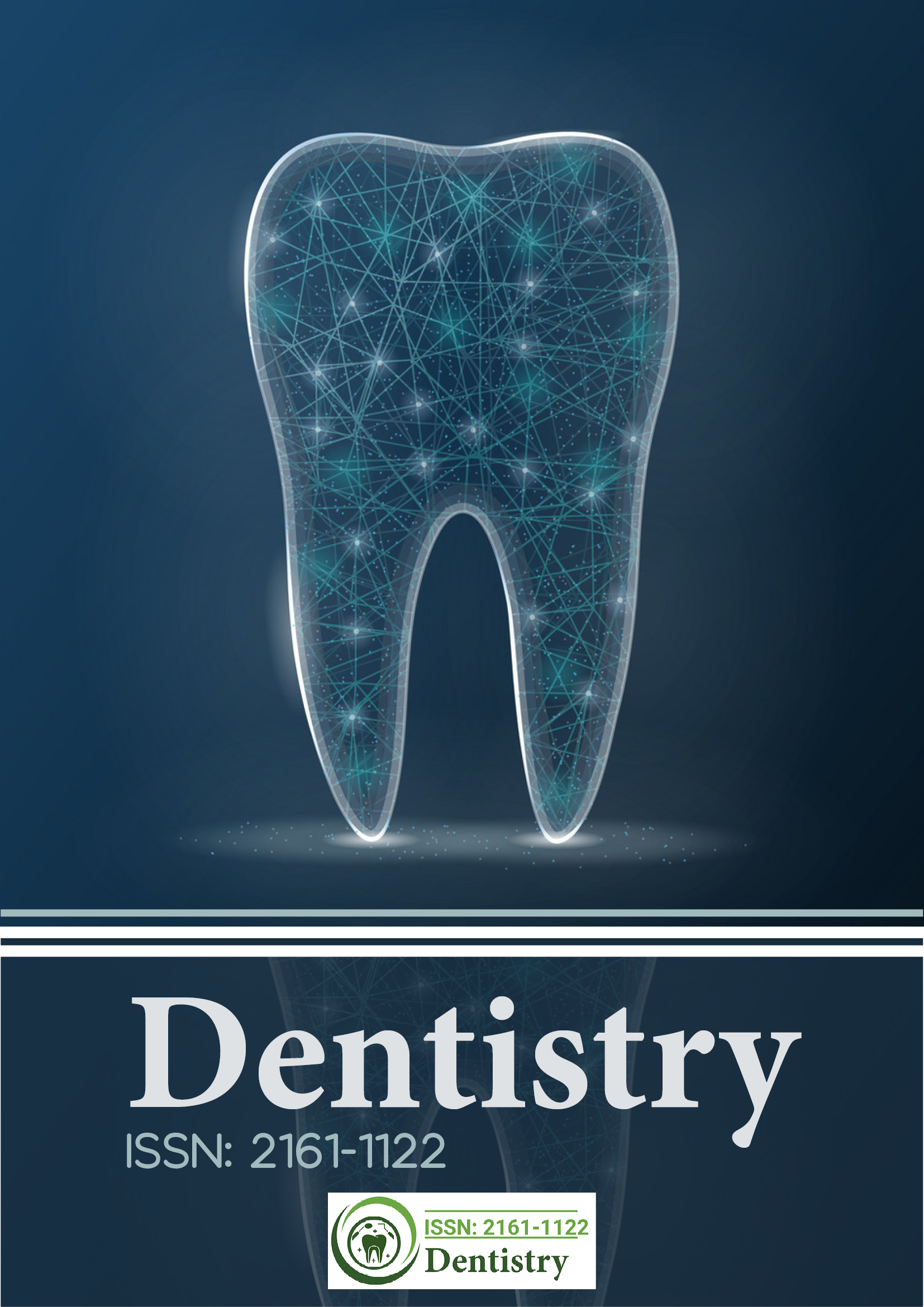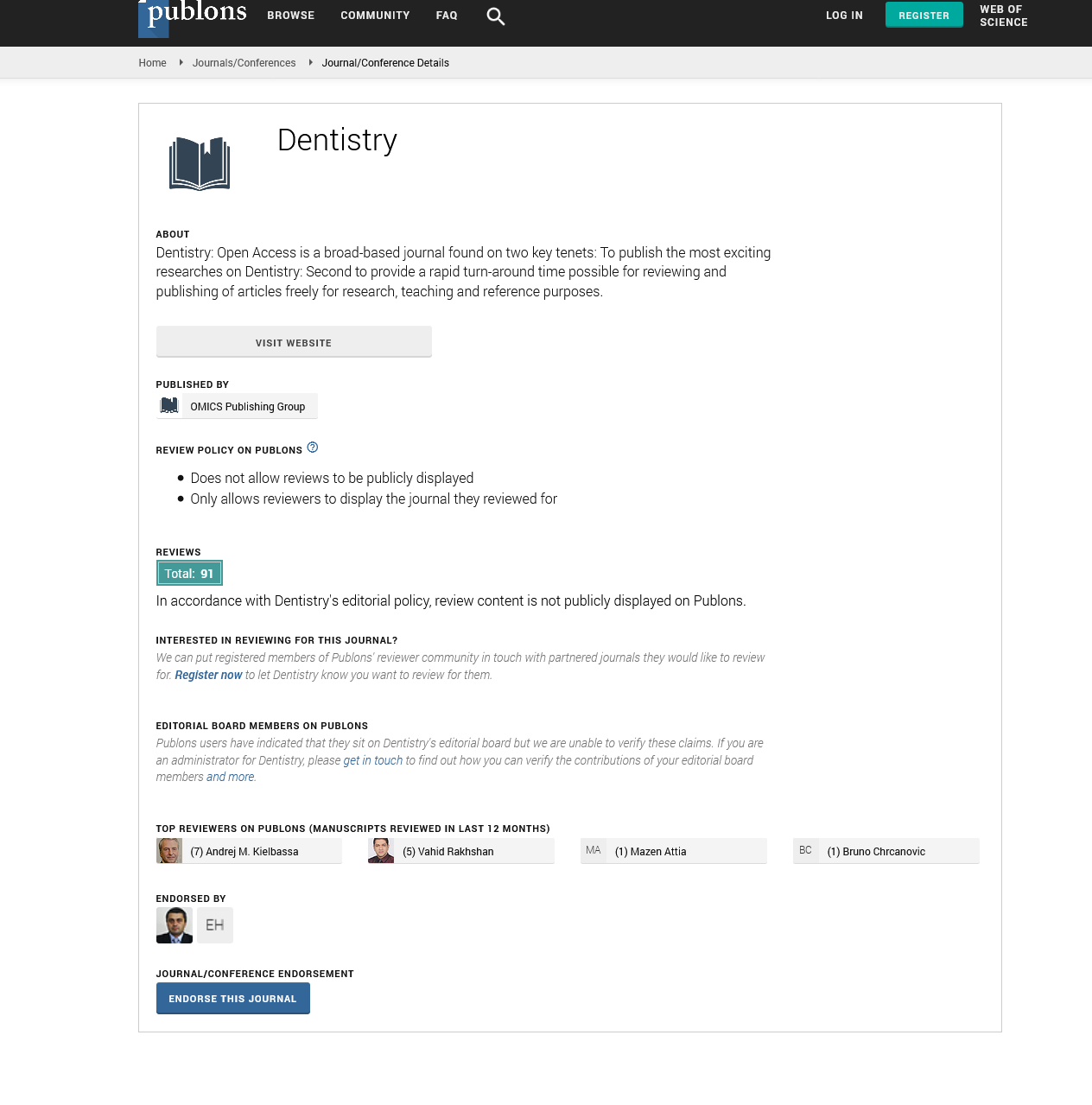Citations : 2345
Dentistry received 2345 citations as per Google Scholar report
Indexed In
- Genamics JournalSeek
- JournalTOCs
- CiteFactor
- Ulrich's Periodicals Directory
- RefSeek
- Hamdard University
- EBSCO A-Z
- Directory of Abstract Indexing for Journals
- OCLC- WorldCat
- Publons
- Geneva Foundation for Medical Education and Research
- Euro Pub
- Google Scholar
Useful Links
Share This Page
Journal Flyer

Open Access Journals
- Agri and Aquaculture
- Biochemistry
- Bioinformatics & Systems Biology
- Business & Management
- Chemistry
- Clinical Sciences
- Engineering
- Food & Nutrition
- General Science
- Genetics & Molecular Biology
- Immunology & Microbiology
- Medical Sciences
- Neuroscience & Psychology
- Nursing & Health Care
- Pharmaceutical Sciences
Perspective - (2025) Volume 15, Issue 2
Thermal Manipulation of Dental Composites and Interfacial Chemistry Effects
Frederik Hilger*Received: 26-May-2025, Manuscript No. DCR-25-29704; Editor assigned: 28-May-2025, Pre QC No. DCR-25-29704 (PQ); Reviewed: 11-Jun-2025, QC No. DCR-25-29704; Revised: 18-Jun-2025, Manuscript No. DCR-25-29704 (R); Published: 25-Jun-2025, DOI: 10.35248/2161-1122.25.15.730
Description
Dental composites are widely used restorative materials that require precise handling properties for clinical success. Heating composites before application has been shown to influence their viscosity, flow and adaptation to cavity walls. The presence and characteristics of silane coupling agents within the composite play a significant role in these changes. Silanes improve filler-matrix adhesion and impact rheological behavior, especially under thermal manipulation.
Composite resins are the materials of choice for restorative dentistry due to their esthetic qualities, mechanical strength and ease of handling. Consistency, viscosity and flow are critical factors that determine adaptation to cavity walls, void formation and marginal integrity. Pre-heating composites has gained attention as a method to improve handling characteristics, particularly for high-viscosity materials. Heating affects polymer matrix mobility, filler dispersion and overall rheological behavior. The silane coupling agent, which binds inorganic filler particles to the resin matrix, influences these properties. Understanding the interaction between heating and silane chemistry provides insight into composite manipulation and clinical performance.
Effect of heating on composite consistency
Heating composites increases molecular mobility within the resin matrix, reducing viscosity and improving flow. Temperature elevation enhances monomer movement, allowing better adaptation to cavity surfaces. Pre-heated composites exhibit improved handling for incremental layering and easier sculpting. High-viscosity bulk-fill composites benefit from heating, as flow characteristics are enhanced without compromising mechanical properties. Temperature-controlled heating devices allow clinicians to maintain composites at specific temperatures before application, standardizing handling characteristics.
Role of silane coupling agents
Silane coupling agents are organofunctional molecules that bond filler surfaces to the resin matrix through covalent or hydrogen bonds. This interfacial bonding affects filler dispersion, rheology and consistency. Upon heating, silane-modified filler particles may influence flow by altering filler-polymer interactions. Properly silanized fillers maintain uniform distribution and prevent particle agglomeration, ensuring consistent material behavior. Differences in silane structure, functional groups and concentration modulate the extent of viscosity change under thermal conditions. Poor silanization can result in uneven flow, clumping and inconsistent handling when composites are heated.
Interactions between heat and silane chemistry
The interplay between thermal energy and silane coupling chemistry determines the composite’s response to heating. Heat increases polymer chain mobility, which can enhance filler-resin interactions mediated by silane. The chemical stability of the silane under elevated temperatures is critical; unstable silane may hydrolyze or degrade, reducing filler bonding and consistency. Well-structured silanes maintain interfacial integrity, allowing composites to retain desirable flow properties during manipulation. Understanding these interactions aids in predicting material behavior and optimizing clinical application techniques.
Clinical implications
Pre-heating composites with consideration of silane chemistry offers several clinical advantages. Reduced viscosity improves adaptation to cavity walls and minimizes void formation. Easier handling allows precise sculpting and contouring, especially in posterior restorations and high-stress areas. Bulk-fill composites benefit from enhanced flow without compromising filler distribution or mechanical properties. Clinicians must select composites with reliable silane formulations and use temperature-controlled heating to achieve consistent results. Knowledge of the composite’s chemical composition and thermal response is essential for predictable outcomes.
Material considerations
Different composites respond variably to heating due to resin viscosity, filler load and silane type. High filler content materials experience more pronounced flow changes when heated. Microhybrid, nanohybrid and bulk-fill composites exhibit unique rheological responses based on filler size, distribution and silanization. Silane-modified nanofillers demonstrate better dispersion and stability, contributing to consistent flow under thermal conditions. Manufacturers optimize silane chemistry to balance mechanical properties with handling improvements when composites are heated.
Heating dental composites influences viscosity, flow and handling properties, with silane coupling agents playing a significant role in consistency changes. Proper silanization ensures uniform filler distribution, maintains interfacial integrity and supports predictable material behavior under thermal conditions. Understanding the interaction between heat and silane chemistry allows clinicians to optimize composite handling, improve cavity adaptation and achieve high-quality restorative outcomes. Advances in composite design, silane formulation and heating protocols will continue to refine clinical techniques and enhance restorative dentistry practices.
Citation: Hilger F (2025). Thermal Manipulation of Dental Composites and Interfacial Chemistry Effects. J Dentistry. 15:730.
Copyright: © 2025 Hilger F. This is an open-access article distributed under the terms of the Creative Commons Attribution License, which permits unrestricted use, distribution, and reproduction in any medium, provided the original author and source are credited.

